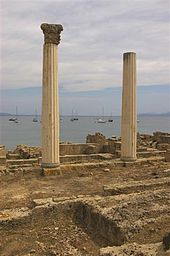Tharros
Tharros (also Tharras, Tarrae or Tarras) is an ancient city on the west coast of Sardinia , of which only remains have been preserved. It is located 20 km west of Oristano in the province of the same name , on the partially only 100 m wide southern tip of the Sinis Peninsula . The name Tharros first appeared on a Roman milestone .
Founded by Nuraghi , the Phoenicians expanded the square into a city and took it over by the Punic and Romans . Between 827 and 1070 n. Chr. It was the capital of Giudicato Arborea . Ibn Jubair (1145–1217) reported as early as 1183 that he saw a ruined city when his ship sought protection from a storm on the Sardinian foothills.
history
The oldest finds in Tharros point to a settlement in the 13th and 12th centuries BC. Close. From the 8th century BC Tharros must have been a Phoenician trading post. This is indicated by the ruins of an acropolis and two tepathim . From Punic times, a 120 m long pier shows that Tharros was in the 6th and 5th centuries BC. Was an important port and trading city.
The Romans defeated in 215 BC. The Punians and adapted the city to their needs. Among other things, wide streets were laid out, which were covered with black basalt slabs; there were also water pipes and a sewer under the street, thermal baths and a hexagonal baptistery .
Close to Tharros are the early medieval Byzantine church of San Giovanni di Sinis and the Ipogeo di San Salvatore, which is accessible in summer .
Finds
Perhaps the oldest, but not found during regular excavations, are bronze figures of the Nuragic culture . They found Cypriot - Mycenaean ceramics from the 13th and 12th century BC. BC, which suggests sea trade. No other Phoenician-Punic settlement on Sardinia has found such quantities of imported ceramics. Tharros apparently had close ties to the Etruscans as early as the 8th and 7th centuries , which Buccherovases refer to. Giovanni Spano estimated the yield from over 100 looted graves at around 4,000 scarabs made of agate , Egyptian glass river, jasper from Monte Arci , carnelian , lapis lazuli and glazed clay, half of which were set in imported gold .
See also
literature
- E. Acquaro, B. Marcolongo, F. Vangelista, F. Verga (eds.): Il Portto Buono di Tharros . Agorà Ed., La Spezia 1999, ISBN 88-87218-23-4 , ( Studi e ricerche sui beni culturali. Monumenti fenici 2).
Web links
Individual evidence
- ^ MO Hermann: "Temple, Cult and Ruin Sites" (Tharros) 1995.
Coordinates: 39 ° 52 ′ 26.4 " N , 8 ° 26 ′ 27.6" E


